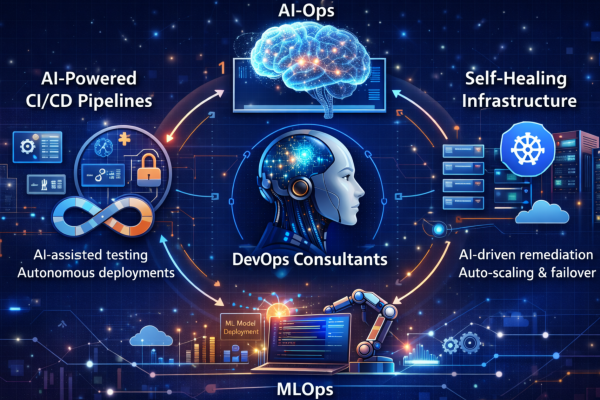A Beginner’s Guide to DevOps Best Practices
In today’s fast-paced tech world, companies are constantly seeking ways to enhance their software development processes. One significant evolution in this space is DevOps. Combining “development” and “operations,” DevOps is a set of practices that aim to shorten the development life cycle while delivering high-quality software continuously. This article provides a deep dive into DevOps, exploring its benefits, challenges, and best practices.
What is DevOps?
DevOps is a transformative approach that fosters collaboration between software development (Dev) and IT operations (Ops), combining cultural and technical practices to streamline workflows and enhance productivity. It focuses on automating and integrating the processes between software development and IT teams to enable the continuous delivery of high-quality software.
Benefits of DevOps
Faster Time to Market:
By automating processes and improving collaboration, DevOps enables quicker releases of new features and updates, helping businesses respond faster to market demands.
Improved Collaboration and Communication:
DevOps fosters a culture of shared responsibility, improving communication and collaboration between development and operations teams. This results in teams that are more cohesive and productive..
Increased Efficiency through Automation:
Automation reduces the time spent on manual tasks, freeing up resources to focus on innovation and improvement.
Higher Quality and Reliability:
Continuous testing and monitoring help detect and fix issues early, resulting in more reliable and higher-quality software.
Enhanced Security:
With practices like IaC and automated compliance checks, security can be integrated into the development process, making it more robust and less prone to human error.
DevOps Tools and Technologies
A variety of tools support the implementation of DevOps practices. Here are some essential categories along with examples:
1. Version Control Systems:
Git, GitHub, GitLab, Bitbucket
2. Continuous Integration/Continuous Delivery (CI/CD) Tools:
Jenkins, Travis CI, CircleCI, GitLab CI/CD
3. Configuration Management Tools:
Ansible, Puppet, Chef
4. Containerization and Orchestration:
Docker, Kubernetes, OpenShift
Monitoring and Logging Tools:
Prometheus, Grafana, the ELK Stack (Elasticsearch, Logstash, Kibana), and Splunk
6. Collaboration and Communication Platforms:
Slack, Microsoft Teams, Jira, Confluence
The DevOps Lifecycle
The DevOps lifecycle is an iterative process that encompasses several stages:
Planning:
This phase entails defining project goals, requirements, and timelines. Tools like Jira or Trello are often used for project management and tracking.
Development:
Code is written, reviewed, and integrated. Version control systems, such as Git, assist in managing code changes and facilitating collaboration.
Building:
Code is compiled and built into executable artifacts. CI tools like Jenkins automate the build process.
Testing:
Automated tests are executed to verify code quality and functionality. Testing frameworks like Selenium and JUnit are commonly used.
Releasing:
The build artifacts are deployed to staging environments for further validation. CD tools manage this process.
Deploying:
Once validated, the application is deployed to production environments. This step is often automated to ensure consistency and reliability.
Operating:
The application is monitored to ensure it runs smoothly in production. Monitoring tools like Prometheus and Grafana help track performance and health metrics.
Monitoring:
Continuous monitoring and logging provide insights into application performance and user behavior, helping teams identify and address issues proactively.
Learn more about continuous testing in DevOps optimization.
Challenges in Adopting DevOps
Cultural Shift:
Moving to a DevOps culture requires a significant change in mindset and practices. Addressing resistance to change can be difficult.
Skill Gaps:
Teams may lack the necessary skills and knowledge to implement DevOps practices effectively. Continuous learning and training are essential.
Tool Integration:
Integrating various tools and technologies can be complex and time-consuming. Ensuring compatibility and seamless workflows is crucial.
Security Concerns:
While DevOps can enhance security, it also introduces new challenges. Properly integrating security practices into the DevOps pipeline is critical.
Managing Complexity:
As systems grow more complex, managing and maintaining them becomes more challenging. Proper documentation and automation can help mitigate this issue.
Best Practices for Implementing DevOps
Foster a Collaborative Culture:
Foster open communication and collaboration among development, operations, and other stakeholders.
Automate Everything:
Automate as many processes as possible, from testing and deployment to infrastructure management. This minimizes errors and accelerates delivery.
Implement CI/CD Pipelines:
Establish robust CI/CD pipelines to ensure code changes are integrated and delivered continuously and reliably.
Embrace Infrastructure as Code:
Use IaC to manage infrastructure. Tools like Terraform and Ansible can help automate infrastructure provisioning and management.
Continuous Monitoring and Feedback:
Implement comprehensive monitoring and logging to gain insights into system performance. Leverage this feedback to drive continuous improvements.
Security Integration:
Integrate security practices into the DevOps pipeline. Automated security tests and compliance checks can help identify vulnerabilities early.
Regular Training and Upskilling:
Invest in continuous learning and training for your teams. Keeping up with the latest tools and practices is essential for success.
Conclusion
DevOps represents a significant shift in how software development and operations teams work together. By fostering collaboration, automating processes, and integrating continuous delivery practices, organizations can achieve faster time to market, improved quality, and greater efficiency. While adopting DevOps comes with challenges, the benefits far outweigh the difficulties. By following best practices and investing in the right tools and training, companies can successfully navigate the transition to a DevOps culture and reap the rewards of enhanced productivity and innovation.
Understanding and implementing DevOps is essential for any organization looking to stay competitive in today’s rapidly evolving tech landscape. Embracing this cultural and technical shift can lead to transformative improvements in how software is developed, delivered, and maintained.
Author







